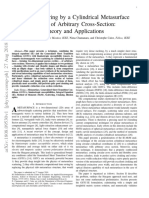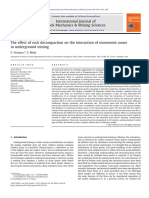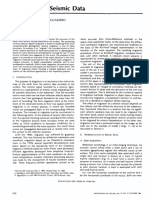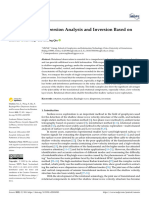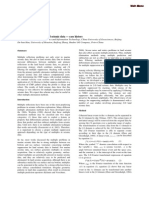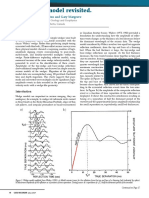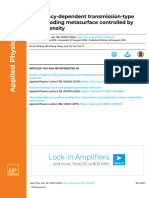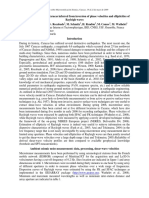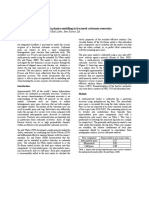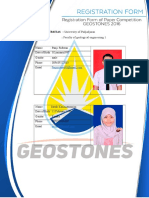Seismic Inversion in Terms Pre-Stack Migration and Multiple Elimination
Seismic Inversion in Terms Pre-Stack Migration and Multiple Elimination
Uploaded by
David Karel AlfonsCopyright:
Available Formats
Seismic Inversion in Terms Pre-Stack Migration and Multiple Elimination
Seismic Inversion in Terms Pre-Stack Migration and Multiple Elimination
Uploaded by
David Karel AlfonsOriginal Description:
Original Title
Copyright
Available Formats
Share this document
Did you find this document useful?
Is this content inappropriate?
Copyright:
Available Formats
Seismic Inversion in Terms Pre-Stack Migration and Multiple Elimination
Seismic Inversion in Terms Pre-Stack Migration and Multiple Elimination
Uploaded by
David Karel AlfonsCopyright:
Available Formats
Seismic Inversion in Terms of Pre-Stack
Migration and Multiple Elimination
A. J. BERKHOUT
Invited Paper
A discussion is givenonmultidimensionalseismicinversion In order to obtain an undistorted version of the reflectiv-
techniques. It is argued that seismic inversion techniques should be itythe propagation effects mustbe eliminatedfromthe
subdivided in two categories:
data. Inversion for propagation effects requires the specifi-
1 ) inversion for the macro parameters of the subsurface, cation of a subsurface model that contains macro features
2) inversion for the detail in the subsurface, such as:
both categories requiring a significantly differentapproach. main velocity and density boundaries,
Ample attention is paid to the different inversion techniques in average velocities and velocity gradients (vertical and
multi-experiment, multi-offset, seismic migration. They are gener- lateral) within each main layer,
allyreferred to as prestack migration.Particularly,techniques average densities and density gradients (vertical and
based on the one-waywaveequation are compared with tech-
niques based on the tweway wave equation. Computational di- lateral) within each main layer,
agrams of the so-called shot record migration are given. The close effective absorption parameter of each main layer.
relationshipbetweenmulti-offset seismicmigrationandinverse
scattering algorithms is shown. Wewill refer to this model as the macro subsurface
A schemefor theeliminationof surface-relatedmultiples is model (Fig. 1).
given. It is proposed as a first step prior to the process of one-way,
multi-offset seismic migration.
INTRODUCTION
I c, = 1500m/s
Exploration seismology is based on analysis of acoustic
waves reflectedfrom different rock layers in the earths
subsurface. Seismic energy, artificially induced into the sub-
surface, encounters discontinuities between the layers and c2=200O+0.8z m l s
is partiallyreflected back to the surface.The returning
reflections are detected and their strengths and arrival times
are recorded.After processing the recorded data for im- c3=4000m/s
provedresolution and signal-to-noise ratio, geophysicists
and geologists derive information from the result concern-
ing the geologic substrates (seismic interpretation).
The properties of the reflected waves are determined by
+ c5=3500+0.5z mls
Fig. 1. An example of a macro acoustic model of the sub-
t w o properties of the subsurface:
surface.
1) The propagation properties, which depend on the
macro acoustic parameters of the medium such as aver-
age velocity and average absorption. Currentmultidimensional seismic inversion techniques
2) The reflectivity properties, which depend on the de- can be subdivided in two categories:
tailed acoustic parameters ofthemedium such as local
variations in velocity and density. 1) inversion for the macro parameters of the subsurface,
2) inversion for the detail in the Subsurface.
Macro subsurface model and detailed inversion result
Manuscript received February 19, 1985; revised October 21, 1985.
The author is with the Delft University of Technology, 2600 GA define togetherthe full solution of the seismic inversion
Delft, The Netherlands. problem (Fig. 2).
0018-9219/86/0300-0415901.Q)W986 IEEE
PROCEEDINGS OF THE IEEE. VOC. 74, NO. 3, MARCH 1 9 8 6 415
seismicmeasurements
model macro detail
0
i+
macrolayer
21
-,-
1-
22
-L
-F
23
--
1 macro layer 2 macro layer 3
-2
macro layer 4 j -1 +, +,
-+
Fig. 2. The solution of the seismic inversion problem con-
sists of a macro subsurface model and a distribution of local
deviations (detail).
In the inversion process for the parameters of a macro
avallable interprelnve avallable
subsurface model multi-offset amplitude and traveltime in- drillinginformation processing geologic lntormPtlOn
formation of main reflecting boundaries should be used.
We may expect that in the near future considerable effort
will be spent in developing effective parametric inversion subsurface
model (ssm)
algorithmsfor anaccurate determinationof macrosub-
Fig. 3. Basic elements ofthe seismic processingscheme,
surface models. consisting of preprocessing, stacking and inversion (or vice
Inversion for detail is carried out in two different ways: versa), and interpretive processing.
a) seismic migration
b) inverse scattering. fluids can be formulated as
Both processes invert propagation operators for the elimina- pv . (3.P) + k2P= 0
tion of propagation effects between the surface and the
depth level of interest. The inversion must be carried out in 01
a band-limited way. Both inversion processes require a
macro subsurface model as input. In inverse scattering this vk22PIPn+=pV. v P (2b)
model is referred to as the reference medium or the wherethevolume under consideration is source free, p
background.A homogeneous reference medium should equals the fluid density, k = o/c, and c = equals fl
not be used in seismic inversion. the fluid propagation velocity. If the fluid contains losses
The output of the seismic migration process consists of a then p and c should be taken complex-valued and
zero-offset reflectivity distribution of the Subsurface. How- frequency-dependent. In the seismic method, the influence
ever, the inverse scattering process computes separate of wave conversion is generally neglected and, therefore,
velocity and density estimates. Therefore, seismic migration wave equation (2) is alsoused for the propagation of
is pre-eminently suited for the estimation of structural longitudinal waves in the subsurface, Pbeing a potential
subsurface information. Inverse scattering is pre-eminently function defined by (la). Conforming to seismic practice, in
suited for the estimation of lithologic subsurface informa- the following we will continue to refer to P as the pres-
tion. There is an increasing interest of the seismic industry sure.
in inverse scattering techniques. In practical situations P(x, y, z, w ) is always band-limited,
In practical seismic situations, inverse scattering should both temporally and spatially and band-limited differentia-
always be applied to multi-offset measurements. Migration tion may, therefore, be represented by convolution [I, ch. l]
can be successfully applied to zero-offset data as well. In
seismic methods zero-offset data are not measured but
a,p = dl(x) *P a,p = 4( y ) P (34
they are simulated by a so-called stacking process (see the a:P = d2(X ) *P atP = d2( y ) * P. (3b)
Appendix). Fig. 3 shows the basic elements of a seismic
processing scheme. TheCMP stacking method will favor An example of stable differentiators are given in Fig. 4.
reflection energy. The CRP method will stack both reflec- Using (3), the band-limitedversion of (2b) may be written
tions and diffractions correctly. In complicated geologic as
situations the short-cut zero-offset simulation by stacking a2p a l n p ap
followedby zero-offset migration (post-stack migration)
az2 a~ a~
+ H2*P=0 (44
falls apart and multi-offset migration (pre-stack migration)
should be used. where
TWO-WAYA N D ONE-WAYWAVE EQUATIONS
Starting with the b_asic equations for the pressure P and
the particle velocity V in the frequency domain
+
- v P = jwpV
- (1a)
Note that without lateral variations we may write after
- v . =jwK-1~ (1 b) Fourier transformation
the acoustic two-way wave equation for inhomogeneous fi2( k,,k,,, w) = k2 - k 2x - k2
Y (44
416 PROCEEDINGS O F THE IEEE. VOL. 74, NO. 3, M A R C H 1986
Fig. 4. Two versions of a band-limited second-order differentiator along the x-axis. Note
that the first version is preferable.
Now, we will define -downgoing and upgoing waves primary energy fulfills the two one-way wave equations
P = P+ + P- (54 ap+
- + jH: * P+ = 0 (loa)
v, = v,+ + v,- (5b) aZ
such that, in agreement with the homogeneous situation
j o p q = jHl * PI (64
where
j o p V ; = -jH1 * P- (6b)
1
or jH: = jHl +-H;l*
joV, = jHl * ( P+ - P - ) (6c) 2 (11 a)
with
Hl* H1 = H,.
1
jH; = jHl - - H;l*
2
p-(
1
p-lH1) .
In the one-way formulations P+ and P-, as defined by (IO),
(Ilb)
Note that without lateral variations we may write are independent during propagation but they are coupled
i,= -/, (7)
at the reflecting boundaries (primary reflection) by the
elastic boundary conditions.
Using the basic equations (la) and (Ib), it canbeeasily Unlike the well-known and often-used Born approxima-
shownthat PC and P- satisfy thefirst-orderdifferential tion, wave propagation according to one-way wave equa-
equations [2], [3, ch. IV] tions (IO)does allowmultiple scattering in the lateral
direction.
Fig. 5 gives a summary on the description of wave propa-
gation of compressional waves as used in multidimensional
seismic inversion.
a P-
--
I
j H l * P- = - - H ; l * KIRCHHOFF-A N D RAYLEIGH-TYPE
INTEGRALS
aZ 2
For a wave field P in a homogeneous fluid with velocity
(8b) distribution c and density distribution p the following ex-
Bear in mind that we have not made any approximations so pression can be derived [3, ch. VI:
far. Now we make the following assumptions:
IP-1 QC IP*I in (8a)
IP+I QC IP-1(8b).
in (9)
Assumptions (9) mean that for downward propagation P- with
does not contribute to P+ and for upward propagation P+
does notcontributeto P-. This
means that
multiple
scattering a l o n g the verfical coordinate is neglected. Hence
pv * (fVP) + k2P= 0
BERKHOUT. PRE-STACK MIGRATION AND MULTIPLE ELIMINATION 41 7
band limited to z ofthe monochromatic pressure re-
wave propagation
o f compressoonal waves sponse
at the surface, ( A x / 2 a ) d Z G ( x ,
z = z,; x,, z,; a),due to a monopole in-
side the medium at depth level z, and
lateral position x,,.
F(zo): column vector which contains the mono-
J:P+H,+ P.O chromatic pressurevaluesat the surface
z = z,, i.e., P ( x , , z,, o) for all n.
alF(zo): column vector which contains the deriva-
Two way: interrelated description on the propagation of primaries tive with respect to z ofthemonochro-
and multiples (up and down). matic p2essure values at the surface z = z,,
One way: independentdescription on thepropagation of the Le., a z P ( x , , z = z,, o) for all n.
downward traveling primary source wave field and the F( z,): column vector which contains the mono-
upward traveling primary reflectedwave fields.
chromatic values ofthe wave field P at
Fig. 5. Summaryonthedescriptionof wave propagation. depth level z,, i.e., P ( x , z,, 0).
Using the above notation, the discrete version of Kirchhoff
integral (13b)maybe formulated for a distribution of ob-
and
pv -vG
i: i+ k2G= -4a13(i- < ) servation points at depth level z,
F(zm) =:c~l(zm,zo)p(zo) -$~(zmtzo)azF(zo)
(14)
uA = p(<)/p(i).
where
Expression (12) formulates a Kirchhoff-type integral for in-
df df
homogeneous fluids. G(F: <) represents the pressure field GOo(zrn,zo) = G ( z o , z m ) and cOl(Zrn~z0)= Go(zo~zm)
at closed surface S due to a monopole in A; n is the unity
vector perpendicular to S pointing inward. Using (12), the indicating that rows and columns should be inter-
I T
wave field can be computed everywhere inside S if P and changed. Note that each columnof C&,(zm,zo) may be
aP/an are given on S. With reference to the half-space viewed as the pressure field at depth level z, due to a
geometry of Fig. 6, (12) may be reformulated as monopole at the surface z = z,. Slmilarly, each column of
G,l(zm,zo) may be viewed as the pressure field at depth
level z, due to a dipole at the surface z = zo (reciprocity).
Remarks:
1) If we include the influence of density changes then it
can be easily seen from (13a) that in the aboveresults
&(z,, z,) should be replaced by
Dp(zm) G(zrn, zo) Di(z0)
Fig. 6. Geometry for Rayleigh-typeintegrals. and G,(z,, z,) should be replaced by
~p(zm)cOl(zm,z,)D~l(z,)
where D,(z,) and D,(z,) are diagonal matrices containing
the density values at depth levels z = zo and z = z,, re-
spectively.
or, for constant densities, 2) If we consider three-dimensional wave propagation
fromthe surface zo to depth level z, for a given two-
dimensionaldistribution P ( x , y , z,, w ) and d Z f ( x , y ,
z = z,, w ) at the surface, then (14) should be modified to
1
Now let us discretize the integrand and let us make use ij(Z,) = - ~ ~ ~ ~ ~ ( z m , z o ) ~ ( z o )
of the matrix notation. First we consider the constant-den- 2 j
sity, two-dimensional situation: 1
- - ~ ~ ~ ~ ( z m , Z O ) a , i j ( ~ (IS)
,)
propagation matrix, the nth column of 2 j
which contains the monochromatic pres-
sureresponse at the surface z = z,, where the vector e(z,) repreznts the samples along the x
( A x / 2 n ) G ( x ,z,; x,, z,; a),due to a- mon- coordinate of P ( x , 8, z,, a),s(z,) contains the samples
opole inside the medium at depth level z, along the x coordinate of P ( x , K, z,, a),and the nth col-
and lateral position x,. umn of t&j)(z,,z,) defines the monopole response at the
propagation matrix, the nthcolumn of plane z = z, for y = x due to a monopole at the surface
which contains the derivative with respect z = zo for y = 8 and at lateral positions x = x , (Fig. 7).
418 PROCEEDINGS O F T H E IEEE. VOL. 74, N O . 3, M A R C H 1986
sents forward extrapolation ofthe primary sourcewave
field and (21b) represents
inverse extrapolation ofthe
7.14 primary reflected wave field.
Similarly, we can derive
+ [~~o(zo,zm)lTi-(~O).
F ( z m ) = [GG(zotzm)jTi++(zo)
7. (22)
Fig. 7. The nth column of G(~~(z,,,,z,) containsthe re- Note again that for loss-free media
sponse in the plane z = z,,, for y = due to a monopole on
the surface z = zo at ( x n , 8). G&(zo,zm) = [ ~ , ( z O , ~ m ) l *
If multiple scattering along the z-coordinate is neglected,
Due to reciprocity (22) can be written as two separate equations
i+(Z,) = [ GG(ZO,Z,)] TF+(Zo) (234
F-(z,) -[ G&(z~,z,,,)] F - ( z ~ ) . (23b)
Let us start with the following condition for the surface Expressions(21) and (23) can be considered as discrete
z = 20: versions of a Rayleigh-type integral for inhomogeneous
alp = 0, a,c = 0. (16) media. The derivation can be simplified by separately sub-
stitutinginthe Kirchhoff integral P+ and P-. One-way
This means that we assume the surface to be reflection- migration techniques arebased on (21) or (23). Two-way
free. Then it follows from (8) that at the surface z = zo the migration techniques are based on (20) and (22).
total pressure P may be split in a downgoing (P) and an Now we will consider the discrete versions of the
upgoing (P-) component which satisfy the one-way wave Kirchhoff- and Rayleigh-type integrals once more by mak-
equations ing use of the series expansion of G and 8,G. First, consider
ap+ the following Taylor series:
-+
az jHl*P+=O
(17 4 - Az,,, + Azrn
+ ...
4
P ( ~ , , , ) = P ( ~ +--a,P(z,)
~ ) +---a,F(ZO)
I! 2!
(24)
*
or, using the two-dimensional discrete formulation, where Az,,, = z, - zo > 0 and P represents the samples of
the Fourier transformed ( t 4 o) discretized wave field at a
a,F+(Z,) + j/+,(zo)F+(zo) = o (184
single depth level. According to the two-way waveequa-
a,F-(zo) - j/+,(zo)F-(zo) = o (18b) tion we may write
where the nth row of matrix Hl(zo) contains the discrete a;F= - H , F + $,a,P (25)
version of lateral operator H, for position x,.
where the rows of H, are defined by the discretized band-
Similarly, we may write for a monopole response at the
limited version of lateral operator
surface z = zo (the monopole is situated in the lower half
space z > zo) alna
plnp
a: + a; - -a, - -a,, + k 2
C(zo) = c+(zo) + Z-(zo) aY aY
with and $, represents a diagonal matrix containing the elements
a, In p. Differentiation of (25) yields
a,C(Zo) + j/+,(zo)Z+(zo) =o (194
a;F =Ani + s,a,i (26)
a,C-(Zo) - j/+,(zo)C-(zo) = 0. (19b)
with
Substitution of (18) and (19) in (14) yields
A, = a,A,-, - Bn-1H2, n = 2,3, (27a)
F(z,,,) = - [ ~ ( ; , ( Z , , Z , , , ) ] ~ ~ ~ F + (z0)
Z= B, = A,-, + a,B,-, + B,,-,B,, n = 2,3, .. . (27b)
-[C&(Z,,Z,,,)]~~,F-(Z= z 0 ) . (20) and A, = 0, B, = 1.
Note that for loss-free media Substitution of (26) in (24) yields
G ( z o t z[m
G )( z O , z m ) l * . F ( z m ) = ~ m ( ~ r n t ~ o ) F+( ~~ o ) ~ (28) ~
In the special situation that multiple scattering along the with
z-coordinate is neglected, (20) can be written as two sep- Azn
arate equations Xm(z,,zo) =I + 7A,(zo), with A, = 0 (29a)
n-1
F+(z,) = - [ ~ ( z ~ , z , , , ) ] ~ ~ , F + ( ~ ~(21a)
) A z
X,(z,,zo) = 7B,(z0), with B, = 1. (29b)
?-(z,) = - [ ~ ( Z ~ , Z , , , ) ] ~ ~ ~ (21b)
~ ~ ( Z ~ ) . n-1
If the upper half space is homogeneous then (21a) repre- Compare (28) with (14)
BERKHOUT: PRE-STACK M I G R A T I O N A N D MULTIPLE ELIMINATION 419
Similarly to (28) we can also derive plex version of W ( z , , z o ) . If this simplification is applied
then W should not contain anylosses ( H i = H,' = H,).
Fig. 8 summarizes one-way and two-way wave field ex-
trapolation into thesubsurface ("downward continuation").
where Compare (34) and (36) with (23).
One-way:
P.P+*P-
Hence, ifwecombine (28)and(30) then the two-way
transfer_function4is obtained (in terms of a matrix) which
relates P and azP at two depth levels
To obtainthe one-way transfer function, westartagain Fig. 8. Summary onone-way and two-way wave field ex-
with Taylorseries (24) but we now makeuse of one-way trapolation (downward continuation from z, to z,,,+,).
wave equations. Firstconsiderthe downward propagating
wave fie'ld ("source wave field")
Making use of one-way expressions (34a) and (35a), the
azF+ + j t t + F+ = si model forthe data of one seismicshot record may be
and, for the higher order derivatives, formulated as
a;F+ -(-j)"/-/iF= 6 F-(zo) = C w ( z o , Z , ) R ( Z , ) W + ( z , , Z o ) ~ + ( z o ) (374
rn
where or, for a sequence of shot records,
% = H,+-, y++ j a z H ; - l .
F ( z 0 ) = C ~ ( Z o , z ~ ) ~ ( z ~ ) w ' ( ~ ~ , Z(37b)
O ) ~ ( ~
Substitution in (24) yields rn
P+(Z,) = w+(z,,zo)F+(zo) or, including also a measurement matrix,
where p-(zo) = D(Z0)
~ rn [ C ~ ~ ~ O ~ ~ (374
, ~ ~
In (33, R(z,) represents the reflectivity matrix for depth
The transfer matrix w'(z,,zo) quantifies the downward level z,; it quantifiesangle-dependent reflection at the
propagationof the primary sourcewave fieldfromthe inhomogeneities in the plane z = z,.
surface zo to depth level z,. Unlike (32), multiple reflec- Expression (37c) shows the relationship between the sub-
tions are not included (one-way formulation). Similarly, we surface reflectivity and the recorded primary reflections in
can derive pre-stack data. It plays an essential role in the understand-
F-(zo) = w(zo,z,)F-(z,) (354 ing of one-way,multirecord,multi-offset, seismic migra-
tion. Wapenaar and Berkhout [4]-[6] have shown that (37)
where can be extended to critical angle data.
Assuming for the moment unity matrices for P + ( z o )and
D ( z o ) , and deleting for notationalconvenience thesub-
script "+" and " - "on W, the response from depth level
The transfer matrix W ( z o ,z,) quantifies the upward prop- z, can be written as
agation of the primary reflected wave fields fromdepth
p - ( z o ) = W(zo,z,)R(z,)W(z,,zo). (38)
level z, tothe surface zo. Again, multiples are notin-
cluded. Hence, an estimate of the reflectivity information canbe
From (35) it follows that obtained from datamatrix F ( z 0 ) by inverting for down-
wardpropagation matrix W(zm,zo) and upward propa-
F-(z,) = F+(z,,zo)F-(zo) (364 gation matrix W(zo,z,)
where (R(z,)) = F(z,,zo)~(zo)F(zo,z,) (394
P(z,,zo) = [ W ( Z ~ , Z , ) ]in- ~
somestablesense. or, using the "matched filter approach"
(36b) (R(z,)) = ~ * ( ~ , , ~ O ) p - ( ~ O ) ~ * ( ~ O , ~ , ) (39b)
.
Generally, P(z,, zo) is represented by the conjugate com- Bear inmind that inversion (3%) yields a band-limited
420 PROCEEDINGS O F THEIEEE, VOL. 74, NO. 3, MARCH 1%
result which still includes theinfluenceofall possible from many depth levels. Hence, apart from the process of
losses during propagation. Expression(39b)describes two inverse wave field extrapolation (up and down) something
deconvolution processes (Fig. 9): else has to be done. Thiscanbeeasily appreciated by
taking into account that inverse wave field extrapolation to
a) W*(z,, zo)P-(zo) describes a lateral deconvolution
depth level z, removes all propagation effects between
process along the columns of P-(zo)
depth levels zo and z,. This means, among others, that the
b) P - ( z o ) W * ( z oz,)
, describes a lateral deconvolution
full traveltime is removed for any event that has been
process along the rows of P-(zo).
reflected at z,. Hence, if we apply inversewave field
Hence, the upward propagation distortion is eliminated by extrapolation to depth level z, then we may conclude:
deconvolving all shot records and the downward propa-
1) The events reflected at the depth levels z < z, will
gation distortion is eliminated by deconvolving all detector
be "over-inverted" and the result can be found at
gathers.
t < 0.
2) The events reflected at the depth levels z > z, will
be "under-inverted" and the result can be found at
t > 0.
3) The events reflected at thedepth level z = z, will
be correctly inverted and the result can be found at
t = 0.
Thus after inverse wave field extrapolation to depth level
z,(m = 1,2;. N ) we should include the following pro-
e ,
cedure:
The data at t = 0 are selected fromthe extrapolation
result and stored as the reflectivity information for depth
level z,.
In seismic migration it is general practice to represent the
reflectivity information of each subsurface depth point by
its wide-angle zero-offset reflection coefficient only (diago-
nal elements of R(z,)). Thismeans that after inverse ex-
trapolation t o depth level z, the zero-offset data at t = 0
are selected to represent the reflectivity property of depth
level z,.
In summary, the above inversion of a multirecord, multi-
offset, seismic data set ("pre-stack migration") consists of
three separate processes (Fig.IO):
t x x--------+
ith shot r e c o r d
Fig. 9. Pre-stack inverse wave field extrapolation consists of
deconvolving all shot records and all detector gathers with
inverse filter W ( - x , - y, Az,q)for the frequency compo-
nents of interest.
If source and detector patterns are used P+(zo) and F
P'
D ( z o ) are not unity matrices anymore. As a consequence, I
the matrices 1nvw.lon for downward
prop.9.tion distortion
Ws(zm,zO) = W(Zm,Zo)P+(zo)
Wd(z0, zm) = D ( Z 0 ) W Z o , z,)
4
FP'F
should be inverted. In practical situations, field patterns
represent zero-phase low-pass filters along the x-axis
and, therefore, data acquisition matrices P ' ( z o ) and D ( z o )
have noinfluenceon the spatial phase; only the spatial
amplitude spectrum will be influenced. As a consequence,
applicationof zero-phasing operators W*(Z,, z o ) and
W * ( z o ,z,) is still effective in the presence of field pat- Fig. 10. "Pre-stack migration" consists of three separate
processing steps, for each depth level.
terns. Optionally, an extra zero-phase spectral shaping op-
erator may be applied. This is generally not yet considered
in practical applications. 1) Inverse wave field extrapolation for upward propa-
So far, we have looked at the inversion problem for the gation (lateral deconvolution of shot records).
response from one depth level only. However, in practice 2) Inverse wave field extrapolation for downward propa-
we have t o applythe inversion process tothe response gation (lateral deconvolution detector gathers).
BERKHOUT: PRE-STACK M I G R A T I O N A N D MULTIPLE ELIMINATION 421
3) Selection of the zero-time samples on the zero-offset
data (zero-offset imaging).
The final result consists ofa wide-angle zero-offset re-
flectivitydistribution as a function of depth. Optionally,
this information may be represented as a function of verti-
cal time. aowca wave field
macro
From Fourier theory it follows that imaging does not Subsurface
model inverae extrapolation of
require an inverse Fourier transformation if the inverse reflected wave fielda
wave field extrapolation process is carried out per frequency
component. Summation of all zero-offset frequency com- -
nexl frequency
ponents yields the desired result image for current depth
Po( x , z,, t = 0) =
I
p,( xz, , , w;) (4.0) -
next depth level
migrated ahot r e c y d
for rn = 1,2;.., M , the subscript 0 meaning that zero-
offset data are addressed only. next shot record
Pre-stack migration, as summarized in Fig. O I ,presents a residual NU0
combine all migrated
very time-consuming process.Thiscan be better appreci- shot recorda
(optional)
ated if one realizes that, in principle, the entire reflectivity I
matrix is available after inversion. However, only the zero-
offset elements are selected during imaging. It canbe Fig. 11. Computational diagram of a shot record migration
shown that this remarkable fact allows a significant sim- (one-way scheme).
plificationof the scheme in Fig. 10 without anyloss of
accuracy for the zero-offset elements! The simplified pro-
cess, shot record migration, will definitely play a very Pn(x,y,zm,w;) =XW(~,y,Azm,wi)
important role in the future of pre-stack seismic migration.
*Pn(x,y,zo,w,) +XO~(X,Y,AZ~~,~,)
Basically, the scheme consists of 5 steps [I, ch. Ill:
1) Forward extrapolation of the source wave field accord- * azPn( x , Y , ~ 0 a;)
, (4.64
ing to (34a)
azPn( x , Y , ~ m 0;)
r = X , Y , A z m , a))
P,(X,YtZmru;) ~ ( ~ , y , ~ ~ m , ~ ~ ) * ~ , t ( ~ ~ y ~ ~ ~ , *~Pn(~ x ), Y , 2 0 0;)+ X11( X , Y , A z m , 0;)
(41 1
* a,P,( x , Y , z o , a;). (6b)
n indicating that we are dealing with the nth seismic
record. In practical situations this step is applied recursively.
2) Inverse extrapolation of the measuredresponse 2) Decompose the total wave field in a downward travel-
according to (36a): ing ( P ) and upward traveling ( P - ) component:
P;(~,~tzmrw;) w*(-x,-y,Azm,w;) P, = Pn + ( - j H 1 ) - * dzPn (474
*P;(x,y,zo,wi). (42) P; = P, - ( - j H 1 ) - * a,P, (47b)
Step 1) and step 2) are often applied recursively. where
3) Computation of zero-offset data at depth level z,:
H,* H1 = H,.
P o n ( x , Y , Z m r a ) = P ~ ( ~ , ~ , ~ m r w ) / P n + ( x , ~ , z (43)
m,w)
3) Continuewith steps 3), 4), and 5) ofthe one-way
the division being carried out in some stable sense. scheme.
4) Imaging Bear in mindthat a two-way scheme handles multiples as
well, and, therefore, the main reflecting boundaries of the
R o n ( xY, t Z m ) = C P o n ( xY, , z m t u;). (44)
i subsurface (marcro subsurface model) must be known
very accurately. If this accurate knowledge is not available,
5) Addition ofthedifferent shot record contributions
a smoothed velocity and density distribution should be
(CDP stacking):
given in order to suppress the multiple related action of the
RO(X, ~ t z m =) C ~ o n ( x ,~ t z r n ) . (45) inversion algorithm.
n The difference between one-way and two-way migration
Fig. 11 shows the computational diagram. is illustrated o n a simple one-dimensional (I-D) example
It is important to realize that shot record migration can (Fig.12). The downwardcontinuation result in Fig. 12(b)
also be formulated with the two-way wave equation. In the simulates a VSP recording. Serious errors mayoccur if
two-way scheme, the above steps 1) and 2) are combined
a) the source signature (amplitude and shape) is wrongly
by making use of (32). Beforestep 3) (and the following
specified;
steps)can be applied, the total wave field P ( x , y , ,z, w )
b) the positions of the two reflectors are wrongly speci-
need be decomposed into P + ( x , y , ~ , , w ) and P - ( x , y ,
fied;
z,, w ) . The two-way pre-stack migration schemecanbe c) the layer velocities are wrongly specified.
summarized as follows [3, ch. 71:
1) Downward continue the total wave field according to The one-way scheme is very robust and relatively insensi-
(32): tive to errors in the above specifications.
422 PROCEEDINGS OF T H E IEEE. VOL. 74, N O . 3, MARCH 1%
0 .25
.50
.75 d t
O
1km F
2k:t
1
0 -amplitude
I I I
1 1
1
Fig. 12. Illustration of thedifferencebetweenone-way and two-waymigrationon a
simple I-Dexample. (a) Model. (b) Response P+(z, t ) +
P-(z, t). (c) P+(z, t), (d) P-(z, t).
(e)Inversionresult. (9 Forward extrapolated sourcewave field. (9) Inverse extrapolated
reflected wave field. (h) Inversion result (one-way).
ELIMINATION OF SURFACE-RELATED MULTIPLE
SCATTERING mathematically, this feedback process can be formulated as
follows:
So far we haveassumed in the one-way techniques
a homogeneous upper half space which includes a reflec- e,,(z,> = T ( z , ) [ S(ZO> + roe,t(Zo>] (*a)
tion-free surface z = zo:a,c = 0, a z p = 0. However, in prac- or
tical situations the surface z = zo represents often a strong
reflecting boundary, where R(zo) = r , / with ro close to
unity. This means that, instead of having all reflected energy
being radiated into the homogeneous upper half space, the
surface will return almost all upward traveling refle_cted
energy back into the low half space(Fig. 13). If S(zo)
represents the source wave field at the surface then,
E E R K H O U T : PRE-STACK MIGRATION AND MULTIPLE ELIMINATION 423
The above multiple elimination technique is multidimen-
eo,<zo) = [I-r , T ( z 0 ) 1 - T ( ~ 0 ~ ~ ( z 0 )( a b )
sional and requires no information about the subsurface;
or, including the detector matrix D(zo) and using a sym- thereflectivity propertyofthe surface should be known
bolic notation only.
In conclusion, a very attractive seismic inversion proce-
dure can beformulated by the followingtwo inversion
processes:
or, using the multirecord presentation
1) Eliminationofthe surface-related multiple scattering
with the aid of (50).
2) Pre-stack seismic migration, preferably by shot record
imaging and CDP stacking.
Expression (49b) can be rewritten as
If themigration process is carried out with a two-way
scheme then multiples within one macrosubsurface are
removed as well, provided the macro model ofthe sub-
surface is accurately known.
From (50) it follows that all surface-related multiples can be
eliminated by applying to the measureddata 4ot(zo) the CONCLUSIONS
inverse matrix
1) Current
multidimensional seismic inversion tech-
[D(ZO)S(ZO) + 04ot(Zo)l-. niques can be subdivided in two categories:
Note that the stability properties of the inverse operator a) inversion for the macro parameters ofthe sub-
dependonthe source and detector field patterns. In its surface
most favorable version b) inversion for the detail in the subsurface.
D( zo) S( zo) = 1.
Macro subsurface model and detailed inversion result de-
To illustrate the principle of the above multiple elimination fine together the complete solution of the seismic inversion
scheme a simple I - D example is shown in Fig. 14. Note the problem.
significant improvement of the signal-to-noise ratio after all 2) a) Inthe inversion process for the parameters ofa
surface-related multiples have been removed. macro subsurface model (parametric inversion) multi-off-
In practical situations, a significant part of the multiple set amplitude and traveltime informationoftheprincipal
scattering problem is caused by surface-related multiples. A reflecting boundaries should be used as seismic input data.
well-known example is the occurrence of water reverbera- b) Inversion for detail is carried out by seismic migra-
tions in marine data. tion or inverse scattering. Both inversion processes re-
Fig. 14. Multiple elimination with the feedback method. (a) Reflectivity model. (b) Pulse
response with multiples. (c) Multiple elimination result: all multiples related to the surface
are removed. (d) Multiple elimination result: all multiples related to the surface and the sea
bottom are removed.
424 PROCEEDINGS OF THE IEEE, VOL. 74, NO. 3, MARCH 1486
quire as input data a macrosubsurface model and the
recorded seismic response. The output of a migration pro-
cess consists of a band-limited version of the wide-angle
zero-offset reflectivity distribution. The output of an inverse
scattering process consists of a band-limited version of the
velocity and density distribution.
3) Seismic migration algorithms canbebased on the
one-way wave equations or on the two-way wave equation.
One-way algorithms do not take into account multiple
0
x
-- source
d e t e c t o rs t a t i o n
scattering along thedepth coordinate. Intwo-way al- Fig. 15. Standardseismicdataacquisition geometry.
gorithms, multiple reflections betweenthe boundaries of
the macro subsurface model are automatically eliminated
during themigration process.Succesful multiple elimina- Each detector station consists of a number of electrically
tion with two-way algorithms requires accurate knowledge connected single detectors (field pattern). Thesignal
ofthe source wavelet and the macrosubsurface model. measured by one detector station is called a seismic trace.
Lack of accurate macrosubsurface information should be All traces related to one source position define one seismic
compensated by representing each reflecting boundary by a shot record. Theremay be %-I024 traces in one shot
gradual transition zone. In this way themultiple-related record. The data of one seismic line may consist of several
action of the two-way migrationalgorithm is suppressed. hundreds of seismic shot records. Typical numerical quanti-
One-way migration techniques are robust with respect to ties are:
errors in source wavelet and subsurface model and there-
fore easier to use than two-way techniques. distance between two adjacent
4) One-way pre-stack migration can be formulated in shot positions : 50 m
terms of two downward continuation processes applied to distance between two adjacent
individual shot records and detector gathers. Taking into detector-station positions : 25 m
accountthat the required output consists of zero-offset length of a seismic trace : 6s
reflectivity only, the above procedure canbe significantly time sampling interval : 2 ms
simplied by downward continuingfor each source position, In a two-dimensional (2-0) seismicsurvey the distance
the source wave field, and its related response (shot re- between adjacent seismic lines may vary from 1 to 5 km. In
cord migration). The final inversion result consists of a a three-dimensional (3-D) seismicsurveyadjacentseismic
superposition (CDPstack) of all migrated shot records. lines may be as close as 50 m. There is a general tendency
5) Two-way pre-stack migration canbe formulated in in the seismic industry to decrease shot and detector spac-
terms of a downwardcontinuation process of the total ings, to decrease the lengthof field patterns, and toin-
+
wave field (source response) for eachseismic experi- crease the number of detector stations.
ment. Afterdecomposing ateach depth level thetotal Fig. 1 6 shows traces ofa synthetic seismic shot record
downwardcontinued result indown- and upgoing wave from a simplified subsurface (a number of plane reflectors).
fieldsthe above one-way schemecan be further used to Primary longitudinal waves are shown only. In the field the
compute the zero-offset reflectivity and to stack the results data are, after A-to-D conversion, stored on tape in a
of all migrated shot records. If macro subsurface models are multiplexed form, i.e., the samples of all traces of one shot
used with smoothed velocity and density distributions, then record are stored together for one time value:
the one-way and two-way migration scheme should yield
comparable results. p(x,,y,tk), with i = 1 , 2 ; . . , /
6) An inversion schemehas been formulated for the j = 1,2;..,1
elimination of surface-related multiples only. it is proposed
for each k-value, ( x , , y) defining the detector station posi-
as a first step in one-way seismic migration.
tion with respect to the related shot position. Hence, the
first step in the processing center consists of demultiplex-
ing each shot record. For land data, the second processing
APPENDIX
step treats the demultipled seismic shot records for irregu-
Exploration seismology is based on analysis of elastic lar surface conditions (elevation and/or weathering prob-
waves reflectedfrom different rock layers in the earths lem) and surface wavesare attenuated (groundroll prob-
subsurface. Seismicenergy, artificially generated into the lem).
subsurface, encounters discontinuitiesbetween the layers Until now, the nucleus of any seismic processing package
and is partially reflected back to the surface. The returning consists of common-mid-point (CMP) processing. This
reflections are detected and their strengths and arrival times means that after the above pre-processing step(s) the data
are recorded.After processing the recorded data for im- are reordered such that all traces with the same mid-point
provedresolution and signal-to-noise ratio, geophysicists between source and detector position are grouped in one
and geologists derive information from the result concern- gather, the so-called common-mid-point gather (CMP
ing the geologic substrata (seismic interpretation). gather). Fig. 1 7 shows traces of a CMP gather. From the rays
Fig. 15 shows a standard data acquisition geometry. The it can be seen that the common reflector points for all
seismic source may consist of dynamite (land), a hydraulic traces in one CMP gather are grouped closely together. This
vibrator (land), or compressedair(marine).Thesource property determines the usefulness of CMP processing.
response is measured by a number of detector stations. Even in fairlycomplicated geologic situations the arrival
BERKHOUT: PRE-STACK M I G R A T I O N A N D MULTIPLE ELIMINATION 425
-n
1t I (b)
Fig. 16. (a)Shotrecordraypaths. (b) Data of a shotrecord
related to the geometry of Fig. I q a ) .
times of the reflectionsfrom one reflector in one CMP
gather can be well approximated by a hyperbolic relation-
ship
Fig. 17. (a) CMP raypaths. (b)
geometry of Fig. 17(a).
CMP gatherrelated to the
(2nAx)*
= ;r +-
d(tm)
where ,t is the zero-offset reflection timeof the mth
reflectorand 2nAx represents the distance (offset) be-
tween the source and detector of the nth trace in the CMP
gather under consideration; K~( t , ) is the so-called stacking
velocity for the mth reflector.
Using a multitrace coherency criterion, vst is determined Fig. 18. CMP gather of Fig. 77(a)after NMO correction.
for anumber of main reflecting boundaries. Fromthese
values interval velocities, forthe layers in between these
boundaries, can be computed. Generally, prior to velocity such that the traveltime effect to move-out is eliminated
analysis the C M P gather is treated by prediction-error fil- (NMO correction). Finally, all NMO-corrected tracesare
tering to achieve some pulse compression and to attenuate added together to form one stacked trace. In this way a
multiple reflections, reverberations, and narrow-band noise. considerable improvement in signal-to-noise ratio may oc-
Given a stacking velocitydistributionfor a given CMP cur and, last but not least, a significant data reduction has
gather, the arrival times of all traces within this CMP gather been achieved.
are corrected (Fig. 18) A stacked trace is considered to be azero-offset trace and
all stacked traces of a seismic line definea stackedor
zero-offset section. Fig. 19 shows a zero-offset section.
426 PROCEEDINGS O F THEIEEE, VOL. 74, NO. 3, MARCH 1986
+X [6] C. P. A.Wapenaar and A. J. Berkhout, Wave field extrapola-
tion techniques for inhomogeneous media which include criti-
cal angle events,Part Ill: Applications in modeling, migration
and inversion, accepted for publication in Geophys. Prospect.,
1986.
BIBLIOGRAPHY
[l] M. Bath and A. J. Berkhout, Mathematical Aspects of Seismot
ogy, vol. 17. Amsterdam, The Netherlands: Geophysical
Press, 1984, ch. 15.
[2] E. Baysal, D. D. Kosloff, and J. W. C. Sherwood, Reverse time
migration, Geophys., vol. 48, pp. 1514-1524, 1983.
[3] -, A two-way nonreflecting wave equation, Geophys.,
VOI.49, pp. 132-141,1984,
[4] A. J. Berkhout, Steep dip finite-difference migration, G e e
phys. Prospect., vol. 27, no. 1, pp. 1%-213, 1979.
[5] -, Wave field extrapolation techniques in seismic
migration, a tutorial, Geophys., vol. 46, no. 12, pp. 1638-1656,
1981.
[6] C. Bolondi, E. Loinger,and F. Rocca, Offset continuation in
theory and practice, Geophys. Prospect., vol. 32, pp.
1045-1073, 1984.
[7] J. F. Claerbout, Fundamentals of Geophysical Data Processing.
New York: McCraw Hill, 1976.
[8] R. W.Clayton and R. H. Stolt, A Born WKBJ inversion
method for acoustic reflection data,Geophys., vol. 46, pp.
1559-1567,1981,
(91 J, K. Cohen and N. Bleistein, Velocity inversion for acoustic
waves, Geophys., vol. 44, pp. 1077-1038, 1979.
[lo] D. A. Cooke and W. A. Schneider, Generalized inversion of
reflection seismic data, Geophys., vol. 48, pp. 665-676,1983.
[ l l ] J. Cazdag, Wave equationmigrationwith the phase shift
method, Geophys., vol. 43, pp. 1342-1351,1978.
[I21 D. Hale, Dip moveout by Fourier transform,Geophys., vol.
49, pp. 741-757, 1984.
[13] D. D. Kosloff and E. Baysal, Forward modeling by a Fourier
method, Geophys., vol. 47, pp. 1402-1412, 1982.
(4 [14] D. D. Kosloff, M. Reshef, and D. Loewenthal, Elastic forward
modeling by the Fourier method, in ExpandedAbstract, S E C s
Fig. 19. (a) Zero-offset raypaths. (b) Zero-offset section
53rd Annu. Int. Meet. (Las Vegas, NV, USA, Sept. 13,1983).
related to the geometry of Fig. 19(a). [15] D. D. Kosloff and E. Baysal, Migration with the full acoustic
wave equation, Geophys., vol. 48, pp. 677487,1983.
[16] L. R. Lines and S. Treitel, A review of least-squares inversion
After post-stack processing such as deconvolution and and its application to geophysical problems, Geophys. Pros-
migration, stacked sections form the basic input data for pect., vol. 32, pp. 159-186, 1984.
[17] C. A. McMechan, Migration by extrapolation of time-depen-
seismic interpretation. dentboundary values,
Geophys. Prospect., vol. 31, pp.
413-420, 1983.
[18] R. Ottolini and J. F. Claerbout, The migration of common
REFERENCES midpoint slant stacks, Geophys., vol. 49, pp. 237-249, 1984.
(191 5. Raz, Three-dimensional velocity profile inversion from
A. J. Berkhout, Seismic Migration-haging of Acoustic Energy finite offset scattering data, Geophys., vol. 4 6 , pp. 837-843,
by Wave Field Extrapolation, vol. 148 (Practical Aspects). 1981.
Amsterdam and New York: Elsevier, 1984. [20] E. A. Robinson, Migration of GeophysicalData. IHRDC Publ.,
L. M. Brekhovskikh, Waves in Layered Media. New York: 1982.
Academic Press, 1980. [21] W. A. Schneider, Integral formulation for migration in two
A. J. Berkhout, Seismic Migration-haging of Acoustic Energy and three dimensions, Geophys., vol. 23, pp. 49-76,1978.
b y Wave Field Extrapolation, vol. 14A (Theoretical Aspects). [22] R. H. Stolt, Migration by Fouriertransform,Geophys., vol.
Amsterdam and New York: Elsevier, 1985. 23, pp. 23-48,1978.
C. P. A. Wapenaar and A. J. Berkhout, Wave field extrapola- [23] P. Temme, A comparison of common-midpoint, single-shot,
tion techniques for inhomogeneous media which include criti- and plane-wave depth migration, Geophys., vol. 49, pp.
cal angle events,Part I: Methods using the one-way wave 18%-1907,1984.
equation, accepted for publication in Geophys.Prospect., [24] S. Treitel and L. R. Lines, Linear inverse theory and decon-
1985. volution, Geophys., vol. 47, pp. 1153-1159, 1982.
-, Wavefield extrapolation techniques for inhomoge- [25] A. B. Weglein, Near-field inverse scattering formalism for the
neous media which include critical angle events, Part II: Meth- three-dimensional wave equation: The inclusion of a priori
ods using the two-way wave equation, accepted for publica- velocity information, /. Acoust. SOC. Amer., vol. 71, pp.
tion in Geophys. Prospect., 1986. 1179-1 183,1982.
BERKHOUT: PRE-STACK M I G R A T I O N A N D MULTIPLE ELIMINATION 427
You might also like
- Gateway To Arabic - Answer Book 2Document10 pagesGateway To Arabic - Answer Book 2Islambase Admin100% (9)
- Critical Reflection Project Management PDFDocument3 pagesCritical Reflection Project Management PDFChickay Galos100% (1)
- Surface Micro Machined AccelerometersDocument10 pagesSurface Micro Machined AccelerometersjamsNo ratings yet
- Geometric Attributes For Seismic Stratigraphic InterpretationDocument8 pagesGeometric Attributes For Seismic Stratigraphic Interpretationmarthymartinezma.08No ratings yet
- 18 Abs231 - Shivamanth AngadiDocument7 pages18 Abs231 - Shivamanth AngadiRajasekhar RayapatiNo ratings yet
- KRITIKAKISDocument6 pagesKRITIKAKISIoannis KapageridisNo ratings yet
- EGSR07 BTDF PDFDocument12 pagesEGSR07 BTDF PDFnpunkdayNo ratings yet
- Automatic Detection and Extraction of Faults PDFDocument5 pagesAutomatic Detection and Extraction of Faults PDFNelson LizarazoNo ratings yet
- MASW Anidis 2009Document10 pagesMASW Anidis 2009Miguel MarquesNo ratings yet
- Surface-Wave Method For Near-Surface Characterization: A TutorialDocument21 pagesSurface-Wave Method For Near-Surface Characterization: A TutorialJavier MtNo ratings yet
- Acoustic Emission Wave Propagation in A Viscoelastic PlateDocument9 pagesAcoustic Emission Wave Propagation in A Viscoelastic Platesarpongbismark2003No ratings yet
- First and Second Week AssessmentDocument10 pagesFirst and Second Week Assessmentwike rosalinaNo ratings yet
- Seismic Inversion Methods and Some of Their ConstraintsDocument25 pagesSeismic Inversion Methods and Some of Their ConstraintsUrsinesetNo ratings yet
- 2010-GEOPHYSICS Reservoir Characterization Using Surface Microseismic Monitoring PDFDocument8 pages2010-GEOPHYSICS Reservoir Characterization Using Surface Microseismic Monitoring PDFVirgina Claudia LatengkeNo ratings yet
- Tao Et Al - 2017 - Reconfigurable Conversions of Reflection, Transmission, and Polarization StatesDocument6 pagesTao Et Al - 2017 - Reconfigurable Conversions of Reflection, Transmission, and Polarization Statesadamhong0109No ratings yet
- Wave Scattering by A Cylindrical MetasurDocument11 pagesWave Scattering by A Cylindrical MetasurSagar ChakravertyNo ratings yet
- Project Report, Ongc, SpicDocument26 pagesProject Report, Ongc, SpicPriya Mishra100% (1)
- 2 Deconvolution PDFDocument112 pages2 Deconvolution PDFFelipe CorrêaNo ratings yet
- Spatial Sampling Issues in FK Analysis of Surface WavesDocument11 pagesSpatial Sampling Issues in FK Analysis of Surface WavesStefano VignaNo ratings yet
- Motion Detection Applied To Microtectonics ModellingDocument10 pagesMotion Detection Applied To Microtectonics ModellingAnonymous lVQ83F8mCNo ratings yet
- Behaviour of Elevated Water Tank Under Sloshing Effect: M. V. Waghmare, S.N.MadhekarDocument4 pagesBehaviour of Elevated Water Tank Under Sloshing Effect: M. V. Waghmare, S.N.MadhekarRANJITH PULIKESHINo ratings yet
- Dynamic Analysis of A Filtered Tailings Deposit With Simplified and Numerical Methods Felipe Rojas 1Document8 pagesDynamic Analysis of A Filtered Tailings Deposit With Simplified and Numerical Methods Felipe Rojas 1RICHARD SEBASTIAN CHAVEZ CASTRONo ratings yet
- 5 Tilak PokharelDocument5 pages5 Tilak PokharelBinod ManandharNo ratings yet
- Nhess 9 451 2009Document8 pagesNhess 9 451 2009reza.khrmiNo ratings yet
- I. Layer Cake Depth Conversion SEISMIC IDocument5 pagesI. Layer Cake Depth Conversion SEISMIC INguyen Ngoc TanNo ratings yet
- Vivanco Et Al IJRMMS 2013Document8 pagesVivanco Et Al IJRMMS 2013Nicolás CamposNo ratings yet
- Guerra 2011Document5 pagesGuerra 2011falla85No ratings yet
- Accurate Stratigraphic Prediction From Seismic: Matt Hall & Eric Trouillot, Landmark Graphics, Calgary, CanadaDocument8 pagesAccurate Stratigraphic Prediction From Seismic: Matt Hall & Eric Trouillot, Landmark Graphics, Calgary, CanadasaNo ratings yet
- 2 Post Stack InversionDocument174 pages2 Post Stack Inversionsantosmonetta2100% (2)
- 10.1306 13181286m922676 2010 High Resolution Electrical Borehole Images While DrillingDocument24 pages10.1306 13181286m922676 2010 High Resolution Electrical Borehole Images While Drilling6qt07l54jNo ratings yet
- Seismic Attributes Analysis To Enhance Detection of Geological Subsurface Features Across The 2016-2017 Earthquake Area (Central Italy)Document4 pagesSeismic Attributes Analysis To Enhance Detection of Geological Subsurface Features Across The 2016-2017 Earthquake Area (Central Italy)shkhawatNo ratings yet
- Ercoli PDFDocument4 pagesErcoli PDFshkhawatNo ratings yet
- ABC212Document11 pagesABC212Keith JenningsNo ratings yet
- Microconnector Bump 2d and 3DDocument11 pagesMicroconnector Bump 2d and 3DGuillermo Javier Alonso TrujilloNo ratings yet
- DocumentDocument10 pagesDocumentIvan BenitesNo ratings yet
- IEEE SPM Deep Learning For Seismic Inverse ProblemsDocument29 pagesIEEE SPM Deep Learning For Seismic Inverse Problemsdeepak kumarNo ratings yet
- Neuromorphi MetasurfaceDocument5 pagesNeuromorphi Metasurfacechristinaxiao1No ratings yet
- Identification of Near-Surface Fault Structure Using Radio Magnetotelluric (RMT) MethodDocument5 pagesIdentification of Near-Surface Fault Structure Using Radio Magnetotelluric (RMT) MethodIlyas AryaNo ratings yet
- The Spectral Element Method: An Efficient Tool To Simulate The Seismic Response of 2D and 3D Geological StructuresDocument26 pagesThe Spectral Element Method: An Efficient Tool To Simulate The Seismic Response of 2D and 3D Geological Structuresyedulla jyothiNo ratings yet
- Ipa03 G 004Document8 pagesIpa03 G 004h77hptc6vkNo ratings yet
- Seismic Migration PaperDocument19 pagesSeismic Migration Paperbo.liu.7987No ratings yet
- Seismic-OMAE format-v6-FINALDocument8 pagesSeismic-OMAE format-v6-FINALMajid HesarNo ratings yet
- Seismic Modeling and Imaging Using Wave Theory For Fault and Fracture IdentificationDocument8 pagesSeismic Modeling and Imaging Using Wave Theory For Fault and Fracture IdentificationGhassen LaouiniNo ratings yet
- Flexible Controls of Terahertz Waves Using Coding and Programmable MetasurfacesDocument13 pagesFlexible Controls of Terahertz Waves Using Coding and Programmable MetasurfacesAnuj SharmaNo ratings yet
- Rayleigh-Wave Dispersion Analysis and Inversion Based On The RotationDocument17 pagesRayleigh-Wave Dispersion Analysis and Inversion Based On The Rotationce21d010No ratings yet
- Multiple Suppression On Land Seismic Data - Case HistoryDocument5 pagesMultiple Suppression On Land Seismic Data - Case Historyvjekod123No ratings yet
- Andres PaperDocument7 pagesAndres PaperRoque Rubén AndrésNo ratings yet
- Homework # 4:: Hazard Analysis, Groundmotion, Response Spectrum and Nonlinear ResponseDocument2 pagesHomework # 4:: Hazard Analysis, Groundmotion, Response Spectrum and Nonlinear ResponseAbhinavNo ratings yet
- 2007 06 Recorder The Wedge ModelDocument6 pages2007 06 Recorder The Wedge ModelBjorn Kjell-eric AsiaNo ratings yet
- FB Veeken DaSilva Inversion 2004Document25 pagesFB Veeken DaSilva Inversion 2004Aicha CherNo ratings yet
- Large Scale Atomistic SimulationDocument10 pagesLarge Scale Atomistic SimulationHiran ChathurangaNo ratings yet
- ExercisesDocument13 pagesExercisesAhmed Magdy Beshr100% (1)
- 3DGeo Seismic AttributesDocument7 pages3DGeo Seismic AttributesMohamed Ibrahim ShihataaNo ratings yet
- Practical Suggestions For 2D Finite Element Modeling of Soil-Structure Interaction ProblemsDocument12 pagesPractical Suggestions For 2D Finite Element Modeling of Soil-Structure Interaction ProblemsJORGE ANTONIO ANAYA QUISPENo ratings yet
- GeoRock - ServicesDocument17 pagesGeoRock - Servicesوجدي بلخيريةNo ratings yet
- FDGGDocument6 pagesFDGGabhishekpaikrayNo ratings yet
- Design of A Unified Scale For The Characterization of Seismic ActivityDocument16 pagesDesign of A Unified Scale For The Characterization of Seismic ActivityInternational Journal of Innovative Science and Research TechnologyNo ratings yet
- Investigation of Surfing Using CFDDocument12 pagesInvestigation of Surfing Using CFDFaisal BhatNo ratings yet
- Res2dinv Res3dinvDocument2 pagesRes2dinv Res3dinvHeruSuharyadiNo ratings yet
- TunnelDocument12 pagesTunnelMasihullah EbadiNo ratings yet
- CLQ-09 CornouDocument4 pagesCLQ-09 CornouHumbertoRalphOrtizAbacheNo ratings yet
- NSB Petrogeo & Play Concepts (Satyana, 2011) PDFDocument57 pagesNSB Petrogeo & Play Concepts (Satyana, 2011) PDFDavid Karel AlfonsNo ratings yet
- Advanced Fault Interpretation: Course Version: 2008.0Document10 pagesAdvanced Fault Interpretation: Course Version: 2008.0David Karel AlfonsNo ratings yet
- Wine List August 2019: Line @winecellarjakarta (0 2 1) 4 5 8 6 5 0 0 5Document33 pagesWine List August 2019: Line @winecellarjakarta (0 2 1) 4 5 8 6 5 0 0 5David Karel AlfonsNo ratings yet
- The SPE Foundation Through Member Donations and A Contribution From Offshore EuropeDocument38 pagesThe SPE Foundation Through Member Donations and A Contribution From Offshore EuropeDavid Karel AlfonsNo ratings yet
- Readme InstallDocument1 pageReadme InstallDavid Karel AlfonsNo ratings yet
- Seismic Processing - Noise Attenuation Techniques PDFDocument3 pagesSeismic Processing - Noise Attenuation Techniques PDFDavid Karel AlfonsNo ratings yet
- Irina Chebo Tar EvaDocument18 pagesIrina Chebo Tar EvaDavid Karel AlfonsNo ratings yet
- An Integrated Solution To Rock Physics Modelling in Fractured Carbonate ReservoirsDocument4 pagesAn Integrated Solution To Rock Physics Modelling in Fractured Carbonate ReservoirsDavid Karel AlfonsNo ratings yet
- Laramide Orogeny: I 1,000 Miles IDocument18 pagesLaramide Orogeny: I 1,000 Miles IDavid Karel AlfonsNo ratings yet
- Petroleum Systems of IndonesiaDocument27 pagesPetroleum Systems of IndonesiaFauzan BasyithNo ratings yet
- Well Seismic Ties SDocument19 pagesWell Seismic Ties SDavid Karel AlfonsNo ratings yet
- Anisotropi Suseptibilitas Magnetik Batuan Ultrabasa Dari Pulau Wawoni - Sulawesi TenggaraDocument8 pagesAnisotropi Suseptibilitas Magnetik Batuan Ultrabasa Dari Pulau Wawoni - Sulawesi TenggaraDavid Karel AlfonsNo ratings yet
- Form Registration Geostones 2016 Paper Contest, FTG Unpad 1Document1 pageForm Registration Geostones 2016 Paper Contest, FTG Unpad 1David Karel AlfonsNo ratings yet
- WellPlan ReportDocument34 pagesWellPlan ReportElmar CahangirovNo ratings yet
- Wise and Foolish BuildersDocument2 pagesWise and Foolish BuildersCherylNo ratings yet
- Indian NumerologyDocument2 pagesIndian Numerologyshashi891965No ratings yet
- Reference 1 Ce 311 ProsipaDocument18 pagesReference 1 Ce 311 ProsipakibilitiNo ratings yet
- Literature: Ms. Reynosa B. RimoroDocument79 pagesLiterature: Ms. Reynosa B. RimoroDexter Carl Bolinto JrNo ratings yet
- Class 11 Final Exam 2018-2019 PDFDocument84 pagesClass 11 Final Exam 2018-2019 PDFSiddharth ChhabraNo ratings yet
- AP Biology 2009 Free-Response Questions: The College BoardDocument4 pagesAP Biology 2009 Free-Response Questions: The College BoardsophisticatedslutNo ratings yet
- Cover-Daftar IsiDocument15 pagesCover-Daftar IsiDanang Tri HatmokoNo ratings yet
- Validitas Isi: Tahap Awal Pengembangan Kuesioner: June 2017Document11 pagesValiditas Isi: Tahap Awal Pengembangan Kuesioner: June 2017Abdul Basith PatedaNo ratings yet
- Review of Related Literature: AN ANALYSIS OF THE PROVINCIAL GOVERNMENT'S SUPPORT FOR CHILDREN IN NEED OF SPECIAL PROTECTION IN SORSOGONDocument4 pagesReview of Related Literature: AN ANALYSIS OF THE PROVINCIAL GOVERNMENT'S SUPPORT FOR CHILDREN IN NEED OF SPECIAL PROTECTION IN SORSOGONNazrene AspraNo ratings yet
- INJUNCTION SC JUF DGEMENT - KRISHNA BAHADUR LAL VS GYANENDRA25311 - 2022 - 6 - 1501 - 52094 - Judgement - 08-Apr-2024Document12 pagesINJUNCTION SC JUF DGEMENT - KRISHNA BAHADUR LAL VS GYANENDRA25311 - 2022 - 6 - 1501 - 52094 - Judgement - 08-Apr-2024Sudhir KumarNo ratings yet
- Carroll, Karanja Keita - The Black Campus Movement - An Interview With Ibram H. RogersDocument9 pagesCarroll, Karanja Keita - The Black Campus Movement - An Interview With Ibram H. RogersDionisio MesyeNo ratings yet
- Language Learning Enhanced by Music and SongDocument8 pagesLanguage Learning Enhanced by Music and SongRadYanNo ratings yet
- Ethics 2Document7 pagesEthics 2Angela ObtialNo ratings yet
- Past Paper Questions On SanteDocument12 pagesPast Paper Questions On SanteIndrani GoswamiNo ratings yet
- Abhinaya: The LyricsDocument3 pagesAbhinaya: The LyricsAl Mahmud0% (1)
- Ssp393 - Audi A5 - Convenience Electronics and Driver Assist SystemsDocument56 pagesSsp393 - Audi A5 - Convenience Electronics and Driver Assist SystemsCyberemuleNo ratings yet
- Ring Laser GyroDocument15 pagesRing Laser GyrosivaNo ratings yet
- TEAcHERS NITE EMCEE SCRIPTDocument6 pagesTEAcHERS NITE EMCEE SCRIPTDJ LoulsNo ratings yet
- Article Explains Succession, Testamentary Powers, Intestate Succession/Inheritance, Meaning/Definition of A Will' and Importance of Making A WillDocument18 pagesArticle Explains Succession, Testamentary Powers, Intestate Succession/Inheritance, Meaning/Definition of A Will' and Importance of Making A Willjeyaprakash kaNo ratings yet
- Ontearning: Audrey Osler and Hugh StarkeyDocument168 pagesOntearning: Audrey Osler and Hugh StarkeyaleyacznikNo ratings yet
- ABC's of Rotary HandbookDocument28 pagesABC's of Rotary HandbookIsmael g. UmaliNo ratings yet
- 4TX 1996 WiringDocument1 page4TX 1996 WiringIco PanchelievNo ratings yet
- Chapter 9 - Benefit Cost AnalysisDocument23 pagesChapter 9 - Benefit Cost AnalysisEric MikleinNo ratings yet
- A Butterfly Effect Volume 1 (Years 1 - 2)Document362 pagesA Butterfly Effect Volume 1 (Years 1 - 2)xdyj2005No ratings yet
- PB AmE B1 WB Audioscript U10Document1 pagePB AmE B1 WB Audioscript U10Adrian CastillaNo ratings yet
- Social Credit C H DouglasDocument69 pagesSocial Credit C H DouglasGiuseppeNo ratings yet
- Feedback: Understanding Strategies and Impact On EFL Learning and Teaching ContextsDocument23 pagesFeedback: Understanding Strategies and Impact On EFL Learning and Teaching ContextsAndrea TorresNo ratings yet















